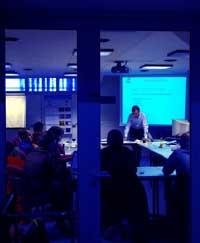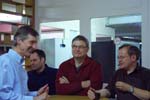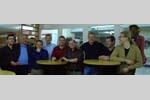 |
 |
|||||||||||||
|
|||||||||||||
|
|||||||||||||
Last week, collaborators from the ILC-HiGrade European Commission Framework 7 Project gathered at CERN, Switzerland for their annual meeting. Each project work package, from cavity, coupler and tuner production to ILC governance studies, was reviewed on 25 February. The ILC-HiGrade project is conducted by six European institutions: DESY, CEA, CERN, CNRS/IN2P3, INFN and Oxford University. 'ILC-HiGrade' stands for 'International Linear Collider and High Gradient Superconducting RF-Cavities' and one of the main objectives of the proposal is a small serial production of accelerating cavities at highest gradients. The European Project is well integrated in the ILC Global Design Effort, complementing the GDE goals and the timelines of the four-year project are well aligned with those of the GDE. During this last year, the "governance" work package coordinated by Brian Foster, European GDE Director led to numerous suggestions on how the ILC could possibly be governed in the future and what could be its funding model, which is one of the important issues that the GDE will have to address during next Technical Design Phase. Another work package ensures that the European site choice has been technically prepared. ILC-HiGrade also addresses key issues like how the mass-production cavities will be achieved in Europe and satisfies the ILC standard. In the course of ILC-HiGrade, the partners should prepare at least 24 fully dressed cavities, which will initially serve as a technical reference for the choice of gradient and eventually as the industrialisation of the high-gradient process. ILC-HiGrade builds on the important synergy between the European ILC-HiGrade project and the European XFEL which uses the same accelerating technique. In fact, one of the objectives of the project is to rely on the established processes of the European XFEL and advancing the quality assurance to achieve the yield of high-gradient cavities. During the annual meeting, new results and scenarios from DESY (Germany) – for cavity production and control – and CEA (France) – for cavity treatment – were presented. The first "HiGrade" cavities should be produced next year. The project also comprises studies of radiofrequency couplers, at LAL (France), where a full conditioning infrastructure should be ready by January 2011. This year, blade-tuners from INFN Milano-LASA (Italy) were shipped to Fermilab (USA) and KEK (Japan) to equip cryomodules which will be tested in real ILC gradient conditions. “The construction of the European XFEL puts the ILC gradient research in Europe in a unique position: no other laboratory will be able to explore the mass fabrication of cavities in such a number. It is an opportunity for us, and an obligation to deliver. ILC-HiGrade is in the middle of this activity and the meeting showed we are well prepared,” said Eckhard Elsen. “I am confident you will see a high gradient in the end.” The ILC-HiGrade project also includes a "dissemination and outreach" section. At the next European Conference on Research Infrastructures in Barcelona, Spain, a poster describing the project activities and the ILC machine will be presented. -- Perrine Royole-Degieux
Read also: Five million Euros to prepare Europe for the International Linear Collider
ILC-HiGrade webpage: www.ilc-higrade.eu |
|||||||||||||
| © International Linear Collider |




